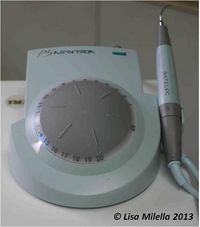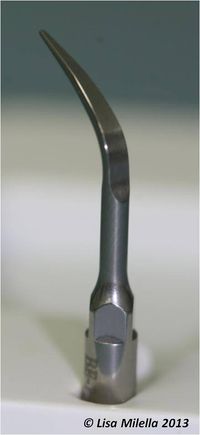Difference between revisions of "Dental Scaling Equipment"
| Line 18: | Line 18: | ||
===Powered Instruments=== | ===Powered Instruments=== | ||
| + | [[File:Ultrasonic scaler tip 2.jpg|right|200px|thumb|Ultrasonic scaler tip<small>''© Lisa Milella 2013''</small>]] | ||
| + | [[File:Piezoelectric ultrasonic scaler.jpg|right|200px|thumb|Piezoelectric ultrasonic scaler<small>''© Lisa Milella 2013''</small>]] | ||
| + | [[File:Ultrasonic scaler tip.jpg|right|200px|thumb|Ultrasonic scaler tip for use with a piezoelectric scaler.<small>''© Lisa Milella 2013''</small>]] | ||
'''Mechanical or powered scalers''' allow easy removal of calculus, are more time efficient to use, and require less training to use effectively. Unfortunately though, they have a greater potential for iatrogenic damage if used incorrectly. There are three types of mechanical scalers, namely sonic, ultrasonic and rotary.<br><br> | '''Mechanical or powered scalers''' allow easy removal of calculus, are more time efficient to use, and require less training to use effectively. Unfortunately though, they have a greater potential for iatrogenic damage if used incorrectly. There are three types of mechanical scalers, namely sonic, ultrasonic and rotary.<br><br> | ||
'''Sonic scalers''' are driven by compressed air, so they require a compressed air driven dental unit for operation. The tip of the scaler oscillates at a sonic frequency. They are generally less effective than ultrasonic scalers, but generate less heat and are thus less likely to cause iatrogenic damage to the tooth surface. Most sonic scalers are designed for supragingival scaling but can be used subgingivally if the appropriate tip is used. <br><br> | '''Sonic scalers''' are driven by compressed air, so they require a compressed air driven dental unit for operation. The tip of the scaler oscillates at a sonic frequency. They are generally less effective than ultrasonic scalers, but generate less heat and are thus less likely to cause iatrogenic damage to the tooth surface. Most sonic scalers are designed for supragingival scaling but can be used subgingivally if the appropriate tip is used. <br><br> | ||
Revision as of 17:07, 20 August 2013
Scaling
Scaling is the procedure whereby dental calculus is removed from the supra- and subgingival surfaces of the teeth. Scaling may be performed using a combination of mechanical and hand instruments. Whilst hand scaling is sometimes more precise and allow better tactile feel, mechanical instruments require less time to remove the deposits and result in less operator fatigue.
Hand Instruments
Hand instruments should be used to remove large, bulky supragingival deposits before going on to powered scalers. Also, hand instruments are required to remove subgingival dental deposits (many mechanical scalers cause potential damage when used subgingivally).
Each hand instrument has a handle, a shank and a working tip. They require frequent sharpening to maintain their sharp edges and the efficacy of the instrument. The handle is available in different shapes and styles to reduce repetitive strain and hand fatigue, as well as allowing better tactile sensation. For example; round, hollow handles are recommended because they are lighter in weight, which increases tactile sense, and minimizes hand fatigue whilst a handle with a larger diameter handle is more ergonomically comfortable. A textured handles (vs smooth handle) is easier to hold and maintain a grip whilst allow the operator to maintain better control.
The part of the instrument that extends from the working end to the handle is called the functional shank. Functional shanks may be angled, curved or straight. The variations in length, flexibility and curvature available allow access to different teeth, and different aspects of these teeth, in human dentistry.
The working end refers to that part of the instrument that is used to carry out the function of the instrument. Working ends can be made of stainless steel or of carbide steel. The working end of a sharpened instrument is called the blade. Carbide blades may hold their cutting edge longer but tend to corrode easily if not cared for properly. Hand scalers have the sharp cutting edge ending with a pointed tip whilst a hand curette ends with a rounded toe to avoid trauma to the tissue when used subgingivally. If a scaler is used subgingivally, the pointed tip will lacerate the gingival margin.
Scalers should be used by gently pulling away from the gingival margin towards the tip of the crown.
Scalers come in a variety of shapes. The most commonly used scaler in veterinary dentistry is the sickle scaler, which can be either curved or straight and in cross section has a blade that is triangular in shape.
Some other types of scalers available are hoes, chisels and files. The most useful of these is the hoe which is a good instrument to remove a large amount of calculus. The width of the blade is applied at the gingival edge of the calculus deposit, and a pull stroke is applied towards the tip of the crown.
Curettes are used for the subgingival removal of calculus and for root surface debridement. There are basically two types of curettes, namely universal and area specific, e.g. Gracey or Columbia curette. The working end of a curette is more slender than that of a scaler and the back and tip are rounded to minimise gingival trauma.
Calculus forceps have been designed to remove large calculus deposits. They have a long, straight beak and a shorter, curved beak. Use carefully to avoid fracture of the crown or trauma to the gingiva.
Powered Instruments
Mechanical or powered scalers allow easy removal of calculus, are more time efficient to use, and require less training to use effectively. Unfortunately though, they have a greater potential for iatrogenic damage if used incorrectly. There are three types of mechanical scalers, namely sonic, ultrasonic and rotary.
Sonic scalers are driven by compressed air, so they require a compressed air driven dental unit for operation. The tip of the scaler oscillates at a sonic frequency. They are generally less effective than ultrasonic scalers, but generate less heat and are thus less likely to cause iatrogenic damage to the tooth surface. Most sonic scalers are designed for supragingival scaling but can be used subgingivally if the appropriate tip is used.
Ultrasonic scalers are the most commonly used scaler in veterinary practice. The tip oscillates at ultrasonic frequencies (25kHz, 30kHz or sometimes slightly higher). They are driven by an electric micromotor. The tip vibration is generated either by a magnetostrictive mechanism, or by a piezoelectric mechanism in the handpiece. In magnetostrictive–type scalers, the mechanism is an electric coil around a stack of laminated ferromagnetic strips or a ferrite rod. The tip vibrates in an elliptical path. Piezo-elecetric-type scalers use a piezo-electric crystal system with piezoceramoc discs that vibrate on a titanium shaft when a high frequency electric current is applied. The tip vibrates only in a linear direction. Metal vibrating at a high frequency generates heat so the tip needs to be cooled to prevent thermal damage to the teeth and soft tissues. The ultrasonic oscillation of the tip also causes cavitation of the water coolant. Cavitation is the production of microscopic bubbles which then implode, realeasing energy. This helps disrupt the calculus on the surface of the tooth and has also been thought to have an antibacterial action especially on anaerobic bacteria. Ultrasonic scalers are generally designed for supragingival use, but tips designed for subgingival scaling are available.
Rotary scalers are described here for completeness but are never recommended in veterinary practice as the potential for iatrogenic damage is high. Non cutting burs are used in a high-speed, air driven hand piece. When the bur is applied to the calculus, the calculus disintegrates and is flushed away by the water spray. They have been shown to cause extensive enamel damage and when used in humans, resulted in post operative pain.


